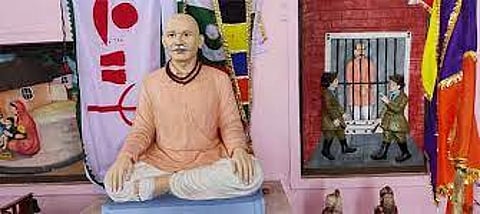
Udaipur- Visitors to the tribal villages at the crossroads of Rajasthan, Gujarat, and Madhya Pradesh often hear the resonant greeting of "Jai Guru," paying homage to Govind Guru, a prominent freedom fighter and social reformer whose legacy continues to thrive even 92 years after his passing.
Govind Giri Banjara, commonly known as Govind Guru, stands as a revered figure in the history of Rajasthan, particularly in the Dungarpur district, as a dedicated social reformer and advocate for the upliftment of the Bhil community. Born in 1858, Govind Guru devoted his life to improving the moral character, habits, and religious practices of the tribals, leaving an indelible mark on the socio-cultural landscape of the region.
In 1883, Govind Guru initiated a transformative movement by founding the "Sampa Sabha," an organization with a mission to serve and unite the tribal people. His visionary leadership aimed at not only addressing immediate issues but fostering a holistic development that would empower the Bhil community. Govind Guru played a pivotal role in uniting the Bhils, spearheading a formidable movement that called for the abolition of the 'Begar' system, improved working conditions, fair wages, abstinence from alcohol, promotion of education, and a commitment to nonviolent methods in their struggle for rights.
Central to Govind Guru's teachings was the promotion of monotheism, advocating temperance, and discouraging criminal activities. His emphasis on embracing agriculture sought to provide the tribals with sustainable livelihoods, breaking the shackles of dependency. Furthermore, he urged the tribals to adopt the cultural norms of the upper castes, aspiring to emulate the behaviour of sahukars or moneylenders.
Inspired by the ritual practices of the Shaivite sect Dashanami Panth, Govind Guru encouraged his followers to maintain a dhuni (fire pit) and hoist a nishan (flag) outside their houses. These symbolic acts were not merely religious but also aimed at instilling a sense of pride and identity among the tribal population.
Govind Guru's vision extended beyond religious and moral reforms; he actively engaged in challenging societal norms, particularly regarding women's rights. Critiquing the treatment of women by the upper castes, he argued that tribal practices were more egalitarian. He denounced the Rajput custom of female infanticide and the prohibition against widow remarriage among both Rajputs and Brahmins, asserting the superiority of tribal practices in this regard.
The impact of Govind Guru's efforts went far beyond the immediate community. His teachings infused a sense of self-esteem and political consciousness among the Bhils, culminating in the Bhagat Movement—a politico-economic revolt against oppressive British policies. This movement not only resisted forced labor and high revenue rates during 1921-22 but also compelled Rajput states, including Dungarpur, Banswara, and Sunth, to adopt more sympathetic measures toward the Bhils, including the abolition of forced labour except for state purposes.
In a short span, Govindguru Banjara gathered a substantial following among the tribals in the states of Sunth, Banswara, Dungarpur, and the British districts of Panch Mahals. His rise, however, faced active opposition from the rulers of the states where he preached. The reasons for this opposition were multifold, ranging from decreased revenues due to his prohibition of liquor to the erosion of the ruler's authority with Govindguru's growing influence.
On November 17, 1913, a heartbreaking incident unfolded at Mangarh Dham hill during the celebration of Govind Guru's birthday. Thousands of tribal devotees had peacefully gathered for the occasion. However, the British authorities perceived this as an opportunity to suppress the Bhil movement and decided to intervene.
Sending over 200 soldiers armed with machine guns and rifles, the British forces surrounded the unsuspecting Bhils, who were unarmed and caught off guard. The soldiers indiscriminately opened fire on the gathering, resulting in a tragic massacre. The Bhils, with no means of escape, were trapped and suffered significant casualties.
The brutality persisted for hours, showing no mercy to the men, women, and children who had assembled at the hill. This ruthless incident led to the loss of approximately 1500 innocent lives, marking one of the darkest chapters in the history of the Bhil community.
The climax resulted in the capture of Govindgiri and his lieutenant Dhirji Punja.Subsequently, those arrested were tried before a special tribunal, with Govindgiri initially sentenced to be hanged. On appeal, his sentence was commuted to life imprisonment. Released in 1919 on the condition of abstaining from political activities, Govindgiri lived in Kamboi near Limbdi until his death on 30 October 1931. Kamboi what is now the Panchmahal district of Gujarat. The family of Harigiri, the eldest son of revolutionary Saint Govind Guru, is settled in Bansia and the family of younger son Amrugiri is settled in Umrai, near Talwara in Banswara district. Even today his family lives here and narrates the horrifying memories of the massacre.
Recognising the significance of the incident, Rajasthan government has taken steps toward preserving the memory of the incident. A panorama was constructed in 2018 at Mangarh Dham as a tribute to the martyrs .
Govindgiri's contributions are commemorated at the Govind Guru Samadhi Mandir in Kamboi, a memorial shrine visited by his followers. The Government of Gujarat opened the Govind Guru Smriti Van, a botanical garden named after him. His legacy lives on through educational institutions, with Shri Govind Guru University in Godhra (established in 2015) and Govind Guru Tribal University in Banswara (established in 2012 and renamed in 2016). The recognition of his grandson Man Singh by the Chief Minister of Gujarat, Narendra Modi, further underscores the enduring impact of Govindguru Banjara's life and work.
Also Read-
You can also join our WhatsApp group to get premium and selected news of The Mooknayak on WhatsApp. Click here to join the WhatsApp group.